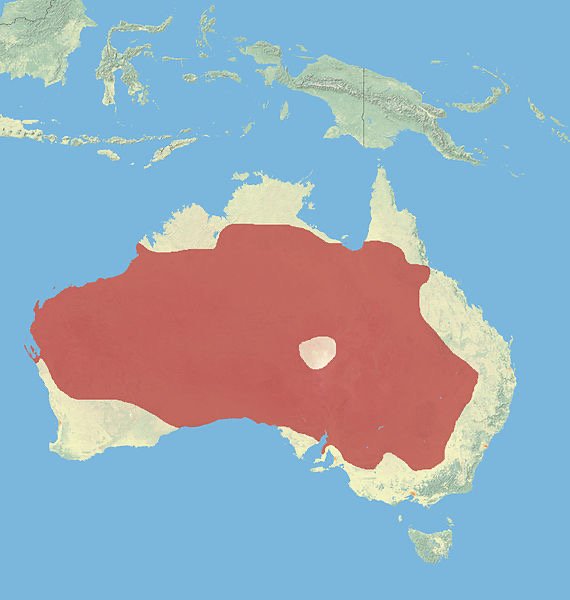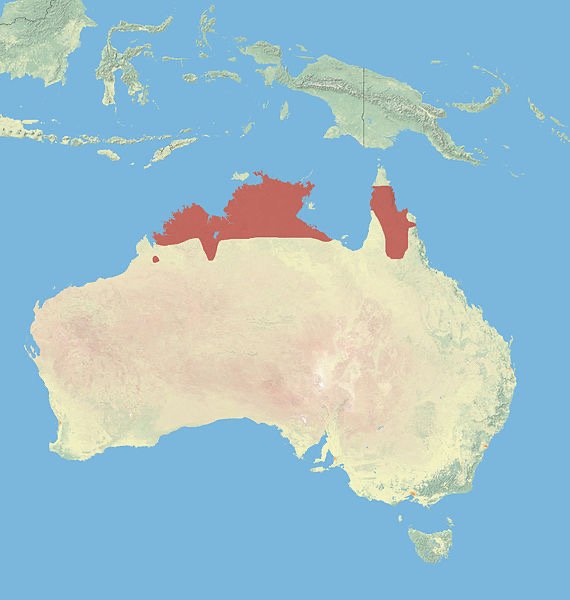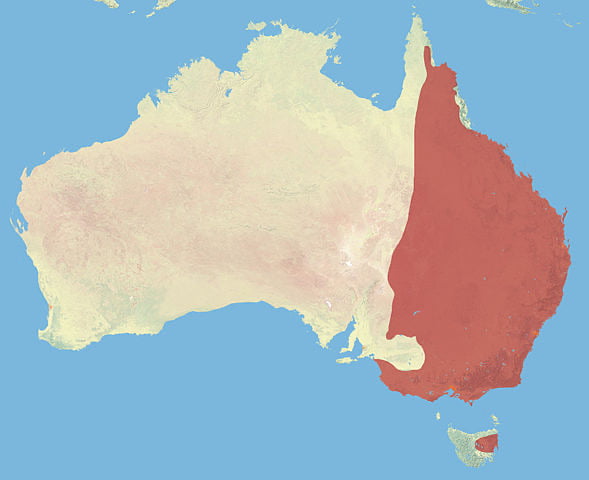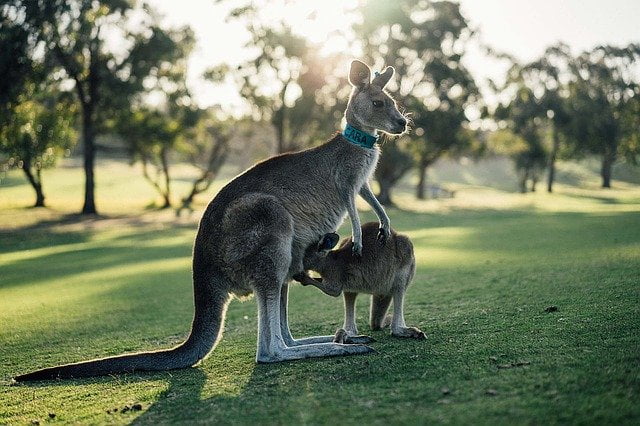Jump to the first section on this page to begin with the topic question. Continue reading for a brief but concise background on kangaroos.
Kangaroos or ‘roos’ as they are colloquially referred to, are pouch bearing terrestrial mammals that belong to the macropodidae family of marsupials along with wallabies, wallaroo and tree-kangaroos, to mention a few.
The term kangaroo is actually used to describe the largest species of this family, with the smallest being the wallabies and intermediary sizes designated as wallaroo. Some distinct members, across different generas also exist, some that look far different from what modern day kangaroos look like.
Despite this nomenclature used to distinguish members of the family however, some species of kangaroos and all species of wallaroo share the same Osphranter subgenus of the macropus genus found within the broad taxonomic family of macropodidae.
So all modern kangaroos do not occupy a separate genus from all species of wallaroo. Some species of kangaroos are found mixed within the subgenus of wallaroo.
Another species belonging to the kangaroo family group are the tree-kangaroos, but this group of animals occupy a separate genus from the three species mentioned above, and are not as closely related to them; they are much more smaller and shorter than them.
All kangaroos are strict herbivorous with some being predominant grazers; feeding on a wide variety of grasses, while others incorporating a significant amount of shrubs and hypogeal fungi in their diets.
Kangaroos have a single stomach compartment for digesting their ingested food despite being heavy grazers, unlike ruminant animals such as cows and goats which have four stomach compartments.
But similar to these ruminants animals, kangaroos are able to regurgitate food and chew cud to aid digestion, but they are rarely found doing so.
The kangaroos is a recognized symbol of Australia and this is evident in the kangaroo being featured as mascot of various sport teams, on sport team names, on the Australian coat of arm, coins and the Australian made logo.
With this breif excerpt, we hope we‘ve been able to communicate a lot of information about the Australian kangaroo. So we’ll now focus our attention on the main topic of discussion which is the range and habitat of kangaroos.
Here is what you’ll learn from this article.
- The modal range of all species of kangaroos.
- The type of habitat that each and every species of kangaroo prefers within its modal range.
Where do kangaroos live?
Kangaroos are endemic to the Australian continent. They are found widespread across the entire region from north to south, east to west.
Modern recognized group of kangaroo are generally split into four distinct species distinguished by a lot of factors such as geographical distribution, external morphology, appearance, behaviour and diet choice.
The species include:
- The Red kangaroo (Osphranter rufus)
- The Antilopine kangaroo (Osphranter antilopinus)
- The Eastern grey kangaroo (Osphranter antilopinus)
- The Western gray kangaroo (Macropus fuliginosus)
Now that you know what countries modern kangaroos are native to and what the different species groups kangaroos are split into, let us expound briefly but concisely into the distribution and habitat range of each species.
The Red Kangaroos
Red kangaroo holds the title for being: the largest of all four extant kangaroo species, the largest of all mammals native to the Australian continent, and finally the largest extant marsupials (or altricial birthing mammal) in the entire world.
Males are covered in short brown fur that fades into a pale bluff coloration below them and on their limbs, while the much smaller females can bear the same coloration as males on their furs or have a blue-grey coloration with a brownish tinge, and an underside that fades into a pale grey coloration.
Males can weigh up to 91 kg in the wild, with the typical range mass being 55 kg to 90 kg,; 121 lb to 198 lb, and average weight being 60 kg. Males usually weigh twice as much as females.
Females are much smaller, having a maximum weight of 45 kg, a typical range mass between 18 kg to 40 kg; 40 lb to 88 lb, and average weight of 30 kg.
The average red kangaroo stands 1.5 m tall and weight 45 kg. Larger males can reach upto 2.1 m while females rarely exceed 1.2 m from head to body length.
Where do red kangaroos live?
Red kangaroos live over most part of central Australia and some part of western Australia. In short, their range spans across mainland Australia excluding the more fertile areas such as the east and south eastcoast, the southern portion of western australia, and the tropical rainforests along the northern coasts.
Habitat:
Red kangaroos inhabit the open dry, arid and semi-arid inland areas of the western and central Australia. This expansive areas include scrubland, shrubland, grassland and deserts habitats.
The highest population of the red kangaroos occurs in the rangelands of western New South Wales.
Red kangaroos often search for food in areas with open plain habitat without trees or bushes, but usually resort back to places with scattered trees to take cover from the fierce claws of the sun.
Map of the red kangaroo habitat

The Antilopine Kangaroo
Antilopine kangaroo otherwise known as Antilopine wallaroo, or the Antilopine wallaby, is a sociable species of kangaroo that is similar to the red kangaroo in term of behaviour and habitat.
The Antilopine kangaroo is the third largest kangaroo after the red kangaroo and the eastern grey kangaroo.
Males have a pale furred ventral side that begins fading into a reddish tan at the sides of the stomach and becomes fully reddish at their dorsal (back).
Females have a similar but much lighter coloration and their head and shoulders are additionally colored grey.
Males have an average head to body length of 1.2 meter while females rarely exceed 0.9 meters. Females have a maximum weight of 20 kg while males can reach more than double that weight at 50 kg.
Where do antelopine kangaroos live?
Antelopine kangaroos inhabit the northern portion of the Australian continent. Their distribution is patchy.
They can be found in the Cape York peninsula in Queensland, in the top end of the Northern territory, and the northernmost region of western Australia, the kimberley.
Habitat:
Antelopine kangaroos prefer tropical habitats with perennial grasses to forage from. They can also be found in vegetation occurring over lower hills and plains. They prefer altitudes less than 500 meters.
Map of antelopine kangaroo habitat:

The Eastern Grey Kangaroo
The eastern grey kangaroo is the second largest kangaroo species and the most abundant of all species in Australia — with a population of several millions.
It is also the second largest and heaviest marsupial and endemic mammal in Australia.
The eastern grey kangaroo is also known as the great grey kangaroo or the forester kangaroo and it is more closely related to the western kangaroo (it looks pretty much like), than the red or antelopine kangaroo.
The eastern grey kangaroo has a soft light grey to brownish-grey coat with a mostly sliver, cream or nearly white underside.
Males can reach height of over 2 m while females rarely exceed 1.2 m. The typical range mass of males is between 50 to 66 kg; 110 lb to 146 lb, although some rare specimens have been observe at 82 kg; 180 lb and 91 kg; 201 lb.
Females have a typical range mass between 17 kg to 40 kg; 37 lb to 88 lb.
Where do eastern grey kangaroos live?
Eastern kangaroos live in the eastern third of Australia which includes: the eastern coastlines and all of queensland with an exception of western south wales, Cape York, and some parts of Tasmania.
Habitat:
Eastern grey kangaroos inhabit fertile parts of eastern Australia from open woodlands mountains with extensive forest cover to grassland.
Eastern grey kangaroos are split into two subspecies, with each inhabiting different areas within the easter third portion. They subspecies and their habitats include.
- Macropus giganteus giganteus: Inhabiting central and eastern Queensland, Victoria, New South Wales, and the southeastern part of southern Australia.
- Tasmanian grey kangaroo (Macropus giganteus tasmaniensis): Found only in Tasmania.
Map of eastern grey kangaroo habitat

The Western Grey Kangaroo
The western grey kangaroo is the smallest of all the four kangaroo species and the closest relative of the eastern grey kangaroo.
The western grey kangaroo is also referred to as western grey giant kangaroo, black-faced kangaroo, mallee kangaroo or sooty kangaroo.
The western grey kangaroo has a thick coarse fur with a coloration ranging from pale grey to brown. Males, just like all other species of kangaroos, are twice as large and more broader than females.
Males have range mass between 40 to 54 kg and stretch an average of 1 m, although rare specimens can grow as large as 7 ft, while females have range mass between 16 to 28 kg and stretch a maximum of 0.9 m.
Where do western grey kangaroo live?
The western grey kangaroo lives in the southern part of Australia and in the kangaroo island off of the southern coast of Australia.
The southern region where they are found include: Southern Queensland, western Victoria, and southern New South Wales. Some of these ranges overlap with those of the eastern grey kangaroo, where the two species can be difficult to tell apart from by mere looking.
The population of western grey kangaroo is more populous in the western areas of the Nullarbor Plain in Western Australia, and western Riverina district of New South Wales.
Western grey kangaroos are also split into two subspecies which inhabit different areas within the southern Australian portion. The species and their habitats include:
- Kangaroo island kangaroo Macropus fuliginosus fuliginosus: Found onlynin the kangaroo island of south Australia.
- Macropus fuliginosus melanops: found widespread in the remaining south Australian portion outlined above.
Habitat:
Western grey kangaroo can adapt to a lot of habitats, but they prefer areas with a variety of trees and vegetation (for cover, food and protection). They can be found in open woodlands, heathland, grassland, forests, gulfs courses and near city areas.
Map of western grey kangaroo habitat

More interesting articles
- Wild Turkey Diet: What do wild turkeys eat?
- Sloth Habitat: Where do sloths live? (with map)
- Kangaroo Predators: What eats kangaroos?
Cite this Article ” (APA Format)
Bunu. M. (2020, July 21). Kangaroo Habitat: Where do kangaroos live?. Retrieved from http://emborawild.com/where-do-kangaroos-live/

